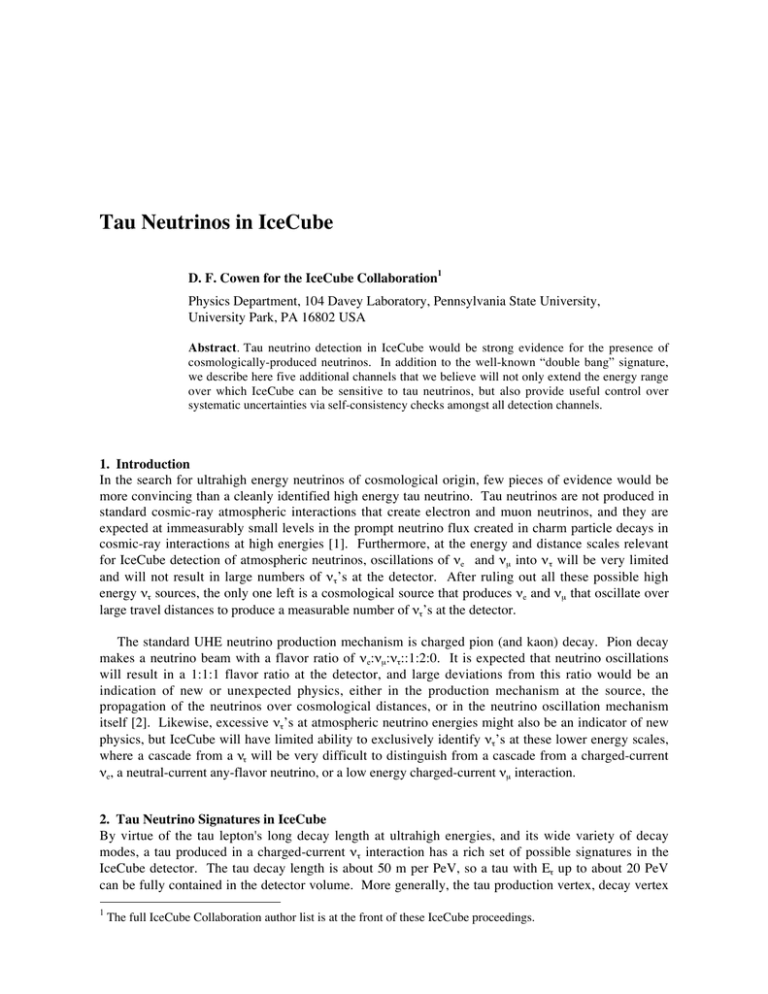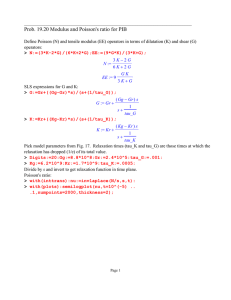Tau Neutrinos in IceCube
advertisement

Tau Neutrinos in IceCube D. F. Cowen for the IceCube Collaboration1 Physics Department, 104 Davey Laboratory, Pennsylvania State University, University Park, PA 16802 USA Abstract. Tau neutrino detection in IceCube would be strong evidence for the presence of cosmologically-produced neutrinos. In addition to the well-known “double bang” signature, we describe here five additional channels that we believe will not only extend the energy range over which IceCube can be sensitive to tau neutrinos, but also provide useful control over systematic uncertainties via self-consistency checks amongst all detection channels. 1. Introduction In the search for ultrahigh energy neutrinos of cosmological origin, few pieces of evidence would be more convincing than a cleanly identified high energy tau neutrino. Tau neutrinos are not produced in standard cosmic-ray atmospheric interactions that create electron and muon neutrinos, and they are expected at immeasurably small levels in the prompt neutrino flux created in charm particle decays in cosmic-ray interactions at high energies [1]. Furthermore, at the energy and distance scales relevant for IceCube detection of atmospheric neutrinos, oscillations of νe and νµ into ν τ will be very limited and will not result in large numbers of ντ’s at the detector. After ruling out all these possible high energy ντ sources, the only one left is a cosmological source that produces νe and νµ that oscillate over large travel distances to produce a measurable number of ντ’s at the detector. The standard UHE neutrino production mechanism is charged pion (and kaon) decay. Pion decay makes a neutrino beam with a flavor ratio of νe:νµ:ντ::1:2:0. It is expected that neutrino oscillations will result in a 1:1:1 flavor ratio at the detector, and large deviations from this ratio would be an indication of new or unexpected physics, either in the production mechanism at the source, the propagation of the neutrinos over cosmological distances, or in the neutrino oscillation mechanism itself [2]. Likewise, excessive ντ’s at atmospheric neutrino energies might also be an indicator of new physics, but IceCube will have limited ability to exclusively identify ντ’s at these lower energy scales, where a cascade from a ντ will be very difficult to distinguish from a cascade from a charged-current νe, a neutral-current any-flavor neutrino, or a low energy charged-current νµ interaction. 2. Tau Neutrino Signatures in IceCube By virtue of the tau lepton's long decay length at ultrahigh energies, and its wide variety of decay modes, a tau produced in a charged-current ντ interaction has a rich set of possible signatures in the IceCube detector. The tau decay length is about 50 m per PeV, so a tau with Eτ up to about 20 PeV can be fully contained in the detector volume. More generally, the tau production vertex, decay vertex 1 The full IceCube Collaboration author list is at the front of these IceCube proceedings. or both may be observable in a single event. The tau can decay leptonically, τ _ eνeντ (branching ratio = ~18%) or τ _ µνµντ (~18%), or hadronically, mainly to charged and neutral pions and kaons (~64%). Note that since the average charged-current ντ interaction produces a tau with 0.75Eν, we will assume Eν = Eτ and refer to either as just “E” for the sake of simplicity. The following subsections, and Figure 1, list six tau neutrino signatures to which IceCube may be sensitive. For each signature we also describe the chief expected backgrounds, energy range over which IceCube will have sensitivity, relevant tau branching ratio, rough IceCube angular acceptance, and energy and pointing resolution relative to that of standard νe and νµ events. In order to assure that we can distinguish a tau track from one or both of its cascades, or from a muon track, we require a tau track length of at least 200 m in the detector. However, energetic downward-going taus will encounter a higher number of DOMs (Digital Optical Modules) [3] per unit track length, decreasing the minimum required track length and hence the energy threshold. Likewise, some taus will simply live longer, also lowering the energy threshold somewhat. Detailed Monte Carlo studies of IceCube sensitivity versus track length will change our simplistically sharp 200 m cutoff. 2.1. Double Bang: The classic ντ signature is the “double bang” in which the initial charged-current interaction creates a hadronic shower and a tau lepton [4]. The tau lepton has sufficient energy to travel a long enough distance in the detector such that when it decays (τ _ eνeντ or τ _ hadrons ντ , total BR = ~82%), it produces a second, separately visible shower. The tau lepton connecting the two showers will also emit Cherenkov light. Depending on the length of the tau track, and the extent to which the two showers are contained, IceCube can get the best of both worlds when reconstructing such an event: the pointing resolution can be comparable to that of νµ, and the energy resolution to that of νe. IceCube should have slightly more than 2π sr acceptance in this channel, since upward-going ντ’s are either absorbed or degraded in energy by passage through the earth. There should be negligible background, although in principle downward-going signal events could be faked by coincident muons from cosmic-ray air showers. The fake rate is probably too small to be a concern, but Monte Carlo studies are needed to verify this. The requirements that the two showers are wellseparated (more than ~100m apart) and contained give a ντ energy acceptance range of E ~ 2-20 PeV. 2.2. Lollipop: If the tau lepton is created sufficiently far from the fiducial volume that the initial hadronic shower is not visible by the detector, and the tau then enters the fiducial volume and decays to produce a shower (total BR = ~82%), the event signature resembles a lollipop: a track ending in a shower. The pointing resolution of lollipop events should be comparable to that of νµ, while the energy resolution will be better but not as good as for νe on account of the missed initial shower. Requiring that the tau have at least 200 m of length in the fiducial volume gives an energy acceptance range of E > ~5 PeV. At this energy scale we are restricted to ~2π sr acceptance since upward-going neutrinos are either absorbed or degraded in energy by passage through the earth. This channel may be sensitive to background from coincident muons from cosmic-ray air showers. Again, this background rate would need to be estimated from Monte Carlo. 2.3. Inverted Lollipop: If the tau lepton is instead created inside the fiducial volume and then decays undetectably outside the volume, the signature also resembles a lollipop, but created in inverse order (shower first, track second). While there is no branching ratio factor here—100% of the ντ that experience a charged-current interaction in the detector volume will produce a tau in the detector volume—and while the pointing and energy resolutions are comparable to that of the non-inverted lollipop, the inverted lollipop is susceptible to an irreducible background from ν µ charged-current events. (A ν µ can have a charged-current interaction in the fiducial volume, creating a shower and a muon, the combination of which will be very hard to distinguish on an event-by-event basis from ντ inverted lollipops. Of course, the event itself is still of interest, especially if its energy is high enough to make it a candidate for being of cosmological origin, but here we are concerned mainly with events that we can convincingly identify as coming from a ν τ.) This channel is also susceptible to background from cosmic-ray muons accompanied by a bremsstrahlung interaction, a background that may be studied (but not eliminated) using an IceTop-tagged muon beam in the data. As with the lollipop signature, requiring that the tau have at least 200 m of length in the fiducial volume gives a energy acceptance range of E > ~5 PeV. As in the double bang and lollipop channels above, this energy scale also restricts this channel to ~2π sr acceptance. 2.4. Sugardaddy: If a tau is created well outside the fiducial volume, then enters it and decays to a muon rather than a shower inside the volume (BR = ~18%), it creates a unique signature which may be detectable. As described in Ref. 5, the much heavier tau will emit significantly less light along its length compared to its lighter daughter muon. This can be idealized as a step-function change in track brightness. For energies between roughly 1 PeV and 1 EeV, the magnitude of the change is expected to be larger than the track energy resolution of IceCube, and hence it should be detectable. There is no background aside from the very unlikely high energy muon that by random chance has significantly more stochastic light-producing interactions at later times relative to earlier times along its length.2 The energy resolution should be comparable to that of a standard νµ event. Requiring at least 200 m of tau track in the fiducial volume sets the energy scale for these events at E > 5 PeV. 2.5. Double Pulse: At energies below the scale at which the two showers of a double bang can be resolved as two separate cascades by the full detector, there is an energy range in which one or more DOMs near the two closely-spaced showers will see a double-peaked structure in its waveform. The lower end of the energy acceptance range for this signature is defined by the ability of a DOM to resolve two waveforms. We assume here that the two waveforms need to be separated in time by ~20 ns, from which we infer a lower energy of ~100 TeV, corresponding to roughly a 5 m tau decay length. Assuming the popular E-2 spectral shape of the neutrino signal flux, this order-of-magnitude improvement in energy sensitivity relative to the standard double bang signature may be a great benefit, even after taking into account the phase space factor reduction in acceptance due to the need for favorable spacing and orientation of the two showers relative to the DOM(s). Note that there will be slivers of phase space where the tau direction is highly favorable for creating resolvable waveforms, possibly decreasing the lower end of the energy acceptance range by an additional factor of 2-3. Monte Carlo studies are underway to map out this phase space in energy and tau orientation. The chief background to this signal would come from two successive bremsstrahlung interactions in a downward-going cosmic-ray muon event. Presumably this background can be addressed simply by removing events with track-like topologies and requiring that all events are well contained within the fiducial volume. 2.6. Tautsie Pop: When a tau is at such low energy that its production and decay vertices are indistinguishable in IceCube, the decay τ _ µνµντ will produce a inverted-lollipop-like signature in the detector and may give us access to very low tau neutrino energies. The additional two neutrinos in the tau decay are the key difference between this signal and its backgrounds from, for example, chargedcurrent νµ interactions. These neutrinos will carry away energy, causing the ratio Eshower/Etrack to be larger by a factor of 2-3 in tau events than in background events. Due to event-to-event variations in Eshower/Etrack and due to the relatively small ratio difference factor, this analysis would have to be done on a statistical basis. Although this channel suffers from the 18% τ _ µνµντ branching ratio, it benefits from its reach to very low energies, starting at roughly where the “double pulse” topology leaves off and extending down to energies perhaps as low as tens of TeV. The lower bound is determined by the energy at which the emerging muon track travels too short a distance to get a good handle on its 2 This potential background may be conservatively estimated from data by measuring the probability for tracks to have a step-function-like change in brightness but in the opposite sense from that expected for tau decays, i.e., brighter then dimmer. energy, although conceivably one could get to very low muon energies using events in which the muon decays in the detector volume. At low enough energies, tau neutrinos from atmospheric interactions may start entering as a “background” to cosmological tau neutrinos. In principle, background from cosmic-ray muons that have a fortuitous bremsstrahlung interaction could be estimated from a sample of IceTop-tagged muons in the data. Background from charged-current νµ interactions would have to be estimated from Monte Carlo. 3. Conclusion Figure 1 summarizes the tau decay channels that may be accessible to IceCube. In addition to the canonical double bang channel, five other channels may also be detectable. The energy range is extended considerably beyond that available from just the double bang channel alone, and in many cases the overlapping energy ranges will permit IceCube to make simultaneous tau neutrino flux measurements using channels with very different systematics. References [1] M. Thunman, G. Ingelman and P. Gondolo, Astropart. Phys. 5, 309 (1996) [arXiv:hepph/9505417]; L. Pasquali and M. H. Reno, Phys. Rev. D 59, 093003 (1999) [arXiv:hepph/9811268]; J. F. Beacom and J. Candia, JCAP 0411, 009 (2004) [arXiv:hep-ph/0409046]; S. I. Dutta, M. H. Reno and I. Sarcevic, Phys. Rev. D 62, 123001 (2000) [arXiv:hepph/0005310]; H. Athar, K. m. Cheung, G. L. Lin and J. J. Tseng, Astropart. Phys. 18, 581 (2003) [arXiv:hep-ph/0112222]; A. D. Martin, M. G. Ryskin and A. M. Stasto, Acta Phys. Polon. B 34, 3273 (2003) [arXiv:hep-ph/0302140]. [2] Kashti and Waxman, astro-ph/0507599 and Barenboim and Quigg, hep-ph/0301220. [3] IceCube Collaboration, Astropart. Phys. 26, pp. 155-230 (2006). [4] J.G. Learned and S. Pakvasa, Astropart. Physics J. 3, p. 267 (1995). [5] T. DeYoung, S. Razzaque, and D. F. Cowen, arXiv:astro-ph/0608486. Figure 1: Summary of τ channels possibly accessible to IceCube, shown as a function of energy and approximate tau decay length, with indications of background level, acceptance, angular and energy resolutions, and specific anticipated background.



